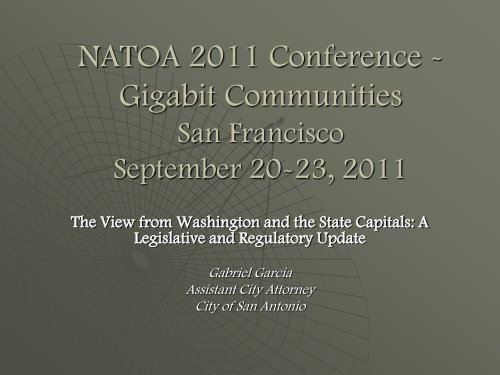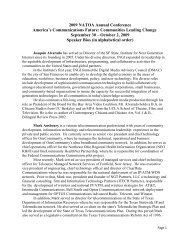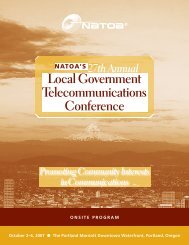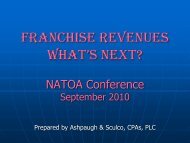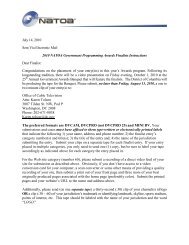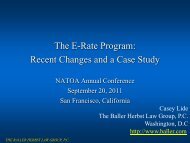Gabriel Garcia Presentation - NATOA
Gabriel Garcia Presentation - NATOA
Gabriel Garcia Presentation - NATOA
Create successful ePaper yourself
Turn your PDF publications into a flip-book with our unique Google optimized e-Paper software.
<strong>NATOA</strong> 2011 Conference -<br />
Gigabit Communities<br />
San Francisco<br />
September 20-23, 2011<br />
The View from Washington and the State Capitals: A<br />
Legislative and Regulatory Update<br />
<strong>Gabriel</strong> <strong>Garcia</strong><br />
Assistant City Attorney<br />
City of San Antonio
Telecom Policy-Making Has Shifted to<br />
Federal Level<br />
Over the last two decades telecom policy-making<br />
has shifted to federal level.<br />
Key drivers accounting for shift:<br />
• State Deregulation<br />
• Transition to IP/Broadband Networks<br />
• Network Convergence<br />
• Expansion of Wireless Service<br />
Shift has been accompanied by reduction in<br />
municipal franchise fee payments and erosion in<br />
local authority.<br />
2
State Deregulation - Texas<br />
Overview of telecom deregulation in Texas:<br />
• 1995: HB 2128 eliminated telecom monopoly regulation<br />
and introduced incentive regulation.<br />
• 1999: HB 1777 eased the entry of new competitors into<br />
telecom market by eliminating authority of cities to grant<br />
telephone franchise agreements.<br />
• 2005: SB 5 facilitated the entry of telecom companies into<br />
the cable industry by eliminating authority of cities to<br />
grant cable franchise agreements.<br />
• 2011: SB 980 eliminates authority of Texas PUC to<br />
regulate all rates, tariffs, terms and conditions of service<br />
for telecom companies under incentive regulation.<br />
Prevents any governmental entity from regulating VoIP<br />
services.<br />
3
Transition of IP/Broadband Networks<br />
Telecom companies are in the process of<br />
transitioning to Internet Protocol (IP) networks.<br />
• On 12/1/09, the FCC issued Public Notice, Comments<br />
Sought on Transition from Circuit-Switched Network to<br />
All-IP Network, GN Docket Nos. 09-47, 09-51, 09-137.<br />
• Evolution of Public Switched Telephone Network (PSTN)<br />
to IP Network:<br />
More efficient use of network resources<br />
Intelligence resides on the edge of the network in servers and<br />
computers (not centralized in telephone switches)<br />
Promotes innovation by end-users as evident from creation of web<br />
services, wireless applications, and new hand-held devices<br />
4
Network Convergence<br />
<br />
<br />
<br />
The convergence of telecom and information technology has<br />
introduced disruptive communications applications.<br />
• End-use devices can provide multiple services (voice, data and video).<br />
• Computer applications can provide the same services as switched<br />
telephone networks (Voice over Internet Protocol – VoIP).<br />
• Computer ship storage capacity continues to expand exponentially<br />
with dramatic results for consumers:<br />
Hand-held devices are getting smaller and smarter (laptops, cell phones)<br />
Reduced costs for data back-up and network redundancy<br />
Promotes wireless mobility – work anywhere & always in touch<br />
New services do not fall neatly into the old regulatory<br />
structure.<br />
VoIP, Internet access & wireless services fall under FCC<br />
jurisdiction.<br />
5
Expansion of Wireless Services<br />
<br />
Between 1992-2007, the<br />
annual contribution of<br />
wireless services to Gross<br />
Domestic Product was<br />
16%, compared to 3% for<br />
the rest of the economy.<br />
<br />
CDC study found the percentage of U.S.<br />
homes with only wireless services is 24.5%<br />
<br />
The explosive growth of<br />
wireless services is leading<br />
residential consumers to<br />
drop landlines.<br />
<br />
As consumers migrate to<br />
wireless services, right-ofway<br />
contributions from<br />
providers to cities go down.<br />
6
Telecom Industry Reduces Municipal<br />
Franchise Fee Payments<br />
Telecom industry (telephone, wireless & cable) has been<br />
working to reduce municipal franchise fees paid for use of<br />
rights-of-way (ROW).<br />
• Cable Modem: FCC ruled it is not a “cable service,” therefore cable<br />
companies need not pay franchise fees on cable modem revenues.<br />
Service uses municipal ROW.<br />
• DSL Service: FCC ruled it is an “information service” not a<br />
“telecommunications service,” thus telephone companies need not<br />
pay franchise fees on DSL service revenues.<br />
Service uses municipal ROW.<br />
• Over-the-Top VoIP Service: FCC ruled it is an “interstate service”<br />
within its jurisdiction.<br />
Service rides on existing broadband connection (cable modem or DSL).<br />
• ROW NOI: FCC may assert jurisdiction to determine payment for<br />
access to municipal ROW base on maintenance cost methodology.<br />
Proceeding pending at FCC.<br />
7
Initial Local Government Reaction to<br />
Industry Changes<br />
Local government reaction to state deregulation,<br />
network convergence, and transition to IP networks:<br />
• Activities previously regulated were transitioned to IT<br />
department.<br />
• Regulatory oversight was eliminated, reduced, or<br />
retargeted elsewhere.<br />
• Lack of regulatory oversight led to reduced interdepartmental<br />
coordination.<br />
• Contracting for converged telecom/information<br />
technology services was approached as technology<br />
procurement.<br />
8
Practical Response to Industry<br />
Changes<br />
Practical response to deregulation, network convergence and<br />
transition to IP networks:<br />
• Recognize that “deregulation” does not mean the absence of<br />
regulation, but rather a shift to federal activities.<br />
Participate in advocacy at FCC, Congress and federal courts.<br />
• Procurement of converged telecom and information technology<br />
requires staff to understands service offerings, evolving network<br />
architecture, legal framework, and regulatory landscape.<br />
Staff needs to acquire new skill set through training or new hires.<br />
Contracts need to include quality of service standards (SLAs), consumer<br />
protections and other items previously mandated by state regulation.<br />
• Telecom procurement and deployment requires closer interdepartmental<br />
cooperation.<br />
In response to this new reality, San Antonio created a new governance<br />
structure to prioritize and align IT investments with the needs of the city.<br />
All major IT investments must be approved by governance board.<br />
9
Policy Implications and Response to<br />
Industry Changes<br />
Policy implications resulting from industry changes:<br />
• Cities are receiving ROW compensation based on yesterday’s telecom<br />
technology and regulatory definitions.<br />
• City franchise revenues are not benefiting from growth in new<br />
broadband technologies although broadband infrastructure uses<br />
municipal ROW.<br />
Policy response to industry changes:<br />
• Cities should call for new regulatory structure that will allow them to<br />
share in the revenues from tomorrow’s broadband technology that<br />
uses municipal ROW.<br />
• New regulatory structure should recognize that wireless towers use<br />
municipal ROW to connect to central offices and other towers for<br />
which cities should be compensated.<br />
• This will require advocacy before Congress, Capitol Hill and FCC.<br />
• <strong>NATOA</strong> is poised to take the lead.<br />
10
Telecom Industry Erodes Local<br />
Government Authority<br />
Telecom industry has successfully eroded local government<br />
authority:<br />
• State Cable/Video Franchising Laws: Many states, including Texas,<br />
have passed laws eliminating the authority of cities to grant cable<br />
franchise agreements and established statewide licensing processes.<br />
• PEG Funding: Elimination of municipal franchise agreements has<br />
limited the used of PEG funds to capital expenditures.<br />
• FCC Cable Franchising Order: FCC order requiring local governments<br />
to take action on a request for a cable franchise agreement within 90<br />
days for providers with ROW authority (ILECs) and 180 days for<br />
others. Reiterates that cable providers need not pay franchise fees on<br />
non-cable services.<br />
• FCC Tower Siting Order: FCC order requiring cities to take action on a<br />
new tower siting request within 180 days, and collocation application<br />
within 90 days.<br />
11
Response to Erosion of Local Authority<br />
<br />
Cities’ response to erosion of their local authority:<br />
• Unsuccessfully opposed many state efforts to eliminate local<br />
franchising authority.<br />
• Unsuccessfully challenged FCC Cable Franchising Order in federal<br />
court.<br />
• Supporting Community Access Preservation (CAP) Act in Congress<br />
which would allow PEG funds to be used for operational expenses.<br />
• Currently challenging FCC Tower Siting Order in federal court.<br />
• Engaged in filing comments at FCC in ROW NOI proceeding.<br />
• Prospectively, expect deployment of many more wireless towers and<br />
outdoor Distributed Antenna Systems (DAS).<br />
12
Closing Observations<br />
<br />
<br />
<br />
<br />
<br />
<br />
<br />
<br />
Telecom policy-making has shifted to the federal level as a result of state<br />
deregulation, network convergence and transition to IP networks.<br />
As a result of changes in telecom industry, cities should take a more<br />
comprehensive approach to telecom/IT procurement.<br />
Telecom industry has successfully eliminated franchising payments to<br />
local governments for broadband services that use city ROW.<br />
Telecom industry has successfully eroded local government authority over<br />
cable franchising and tower siting.<br />
Cities are receiving franchise payments based on yesterday’s technology.<br />
Cities should call for new regulatory structure that will allow them to<br />
receive franchise payments based on tomorrow’s technology.<br />
<strong>NATOA</strong> is poised to take the lead on this issue.<br />
Expect deployment of many more wireless towers and outdoor DAS<br />
systems, and work for new regulatory structure to recognize that these<br />
wireless facilities uses city ROW.<br />
13


